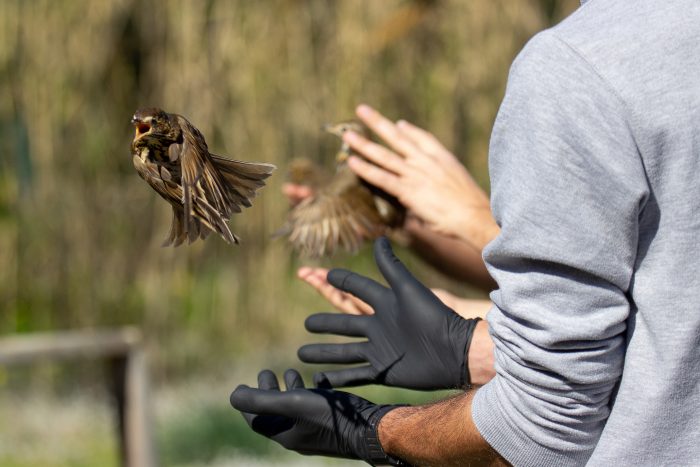On the frontlines is our monthly newsletter section covering the activities of BirdLife Malta’s conservation, policy and nature reserve (Salina, Simar, Għadira and Foresta 2000) teams, together with an update about rare and scarce bird species observed.

End of the hunting season
The autumn hunting season is now closed. The five-month long season ran between 1 September 2023 and 31 January 2024. This means that any form of bird hunting or trapping activity using guns, nets or bird callers is not permitted, giving our country a much-needed respite from bird killing activities.
BirdLife Malta asks the public to continue to keep an eye out for any illegal hunting or trapping activities that might be encountered. Any illegality should be reported directly to the Environmental Protection Unit (EPU) of the Malta Police Force on 119. You can also inform us by messaging us on Facebook Messenger, calling our office number 2134 7645 or on our emergency (out of office) number 7925 5697. For more info about hunting and the hunting seasons click here.
Calls for Conservation Assistant and Spring Watch volunteers
The Conservation department has opened one short-term and one long-term volunteer position to help us get through the current year.
The short-term volunteering experience is about the monitoring of illegalities during the spring hunting season. We are on the lookout for volunteers to assist with our annual Spring Watch operations and join the campaign to abolish spring hunting in April. It is anticipated that there will be two species that will be legal to shoot: the Common Quail and European Turtle-dove. However, every spring many other protected species fall victim to illegal killing.
This voluntary position is fieldwork-based and will involve long days in the countryside. We will be looking for evidence of wildlife crime and report such incidents to the police for further investigation.
If you possess good bird ID and/or observational skills, and are comfortable with long days in the field, then this could be the opportunity for you! Volunteers who are confident and willing drivers would be particularly welcome.
For more information regarding this work, or if you’re interested to join this year’s Spring Watch camp, please email us by the 27 March 2024.
The long-term Conservation Assistant volunteering position provides you with the opportunity to contribute to rehab of birds, joining releases and learning how to take care of protected birds. This is a lifetime experience which opens up an opportunity for future full-time employment.
At the same time you’ll benefit from an amazing experience working abroad through the European Solidarity Corps (ESC) scheme. Although this is a volunteering position, we provide accommodation and cover all living costs for the duration of the one-year term which starts in March 2024. The select candidate will also have their travelling expenses to Malta reimbursed and receive a monthly allowance.
We highly recommend that you visit our job section for further information before applying.
Applications close on Tuesday 20 February 2024. Zoom/Skype interviews will take place shortly afterwards.
Hunter acquitted on appeal against charge of killing protected bird
On 29 April 2022, during the spring hunting season, BirdLife Malta recorded an incident in Nadur, Gozo. The footage captured by BirdLife Malta showed a hunter, Brandon Said, picking up an injured protected Eurasian Collared-dove and killing it using his mouth.
The Gozitan hunter was afterwards found guilty based solely on the video evidence, which Magistrate Leonard Caruana considered to be unambiguous.
Said had his shotgun seized and paid a fine of €1,200 in addition to a two-year hunting ban.
However, on appeal, the hunter’s conviction for taking a protected bird was reversed after Judge Consuelo Scerri Herrera rejected the video evidence that purportedly showed the hunter committing the offence.
The person who filmed the incident as well as her companion were indeed unable to identify the accused as the person who picked up the bird in the footage and appeared to kill it.
Scerri Herrera further noted that since no carcass has been shown as evidence and the video is inadmissible, the appellant is correct to assert that there is no proof of the type of bird that was killed.
The judge reversed the restriction on Said’s hunting licence, acquitted him of all accusations, and revoked the first sentence.
It must be mentioned that the hunter was represented in court by Deborah Camilleri, who is the wife of Clint Camilleri, the minister responsible for hunting, planning and Gozo.
Conservation Standard Method Workshop in Novi Sad
Our Conservation Coordinator Alice Tribe, and Conservation Officer Marcella Giornetti, attended a workshop in Novi Sad, Serbia, regarding the Conservation Standard Methods delivered by EuroNatur and BirdLife Europe.
The goal was to provide training in a range of conservation standards, such as project planning and project evaluation, to conservationists from each BirdLife Partner.
Part of the workshop training was based on four real case studies: smuggling of birds through Slovenia, poisoning of birds in Serbia, waterfowl hunting in Turkey (Gediz Delta) and bird trapping in Egypt (Lake Burullus).
Many bird conservationists throughout the Mediterranean region were able to network and exchange ideas as a result of this event, which improved their understanding of the challenges affecting bird conservation.



Our conservation team during the workshop in Serbia
Rehabilitated birds
During January, BirdLife Malta received numerous reports of weak gulls stranded along the coast, some of which had serious illnesses. We are the only organisation in Malta which has a rehabilitation centre for wild birds, and able to provide first aid and therapy to birds that require attention.
BirdLife Malta managed to release three Yellow-legged Gulls and three Black-headed Gulls back into the wild, after a period of rehabilitation.
We also released a Eurasian Collared-dove, which was found in Msida by the marina. The bird was admitted with an extremely low weight and had a severe illness, but after special treatment, we are very proud to say that the bird recovered well.
A Spanish Sparrow was released too, after the bird had sustained injuries from a cat attack.
The end of January also meant the end of the autumn hunting season. Due to the extent of illegal hunting across the Maltese Islands, BirdLife Malta chose not to release certain species while the hunting season was still open. On 1 February, we released a Common Kestrel which had previously been illegally shot, as well as three Song Thrushes and the Eurasian Collared-dove mentioned above.
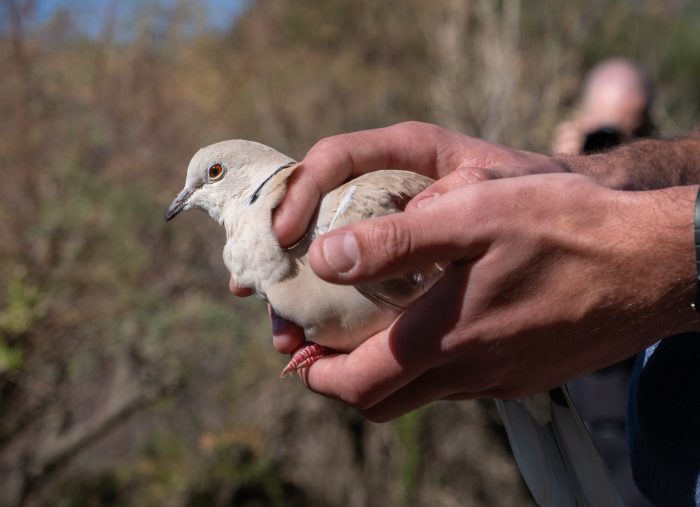

Left to right: The released Eurasian Collared-dove and Common Kestrel

Salina Nature Reserve
Sightings
It is a must to visit Salina during December and last December was no exception. Gulls, gulls, gulls, and some terns are the highlights of December. On most days, they number in their thousands providing a constantly changing scene. They chase each other, or rest or feed but always with an eye for danger. This was the case when a Western Marsh-harrier tried its luck to catch a gull, but the “organised” chaos that ensued, ensured that the bird of prey left empty handed. Apart from this, the regulars were always present with Western Water Rail, Reed Bunting and numerous Common Chiffchaffs on the wetland side and Common Redshank, Common Sandpipers, White Wagtails and Little Egrets in the saltpans. Common Kingfishers were likewise always present, needing a sharp eye to spot them darting across the saltpans.




Works
With the delivery of several showcases, the Salt Museum is nearing completion, hopefully opening its doors to visitors in early 2024. More informative display boards were printed and installed. Part of the existing freshwater stream at the wetland was diverted into a newly dug channel to effectively double the length of the stream. This area has become excellent for birds like Grey Wagtail, Meadow Pipits and Common Chiffchaffs.
Għadira Nature Reserve
Sightings
This winter was particularly poor in the numbers of wintering birds at Għadira reserve. Rather warm days were experienced throughout January with negligible rain. Amongst the species noted almost daily were a Little Grebe, a Black-necked Grebe, a Common Sandpiper, Common Kingfishers, White Wagtails, Meadow Pipits, Common Stonechats, Common Chiffchaffs, European Robins and Common Starlings. A female Common Teal was seen frequently. A female Gadwall was seen on 18 January and five Northern Shovelers stayed at the reserve for a day on 26 January. Eurasian Collared-doves were noted in display flight daily and Sardinian Warblers and Cetti’s Warblers were also noted in territorial behaviour as warm days reminiscent of spring triggered breeding behaviour.





Works
Pruning works were done throughout the month as African Tamarix and Chaste Tree shed their leaves in winter. Cuttings of both species were also planted in the nursery.
As done in previous years during this month, the north and west perimeter of the nature reserve were hedge-trimmed and the access road cleared to allow access to farmers and walkers.
A number of MCAST, Junior College and St Aloysius Sixth Form students gave a helping hand in all works including control of invasive plants, shredding of pruned material and also in nursery work for propagation of indigenous trees.


Planting of Tamarix and Chaste Tree cuttings at Għadira Nature Reserve
Simar Nature Reserve
Sightings
Mid-winter is the time when wintering birds are settled in the reserves. Up to 15 Common Coots are present with some also pairing up. A Gadwall and a Northern Shoveler, both females, have also remained. A male Common Teal has also stayed and his presence is often known from his characteristic call. One of the two Little Grebes present has already moulted into its breeding plumage and is frequently heard calling from within the dense vegetation in the wetland. A Black-necked Grebe was seen for most of the month, whilst a good number of Western Water Rails could be heard calling from around the wetland. Common Kingfishers are also spending their winter at Simar.



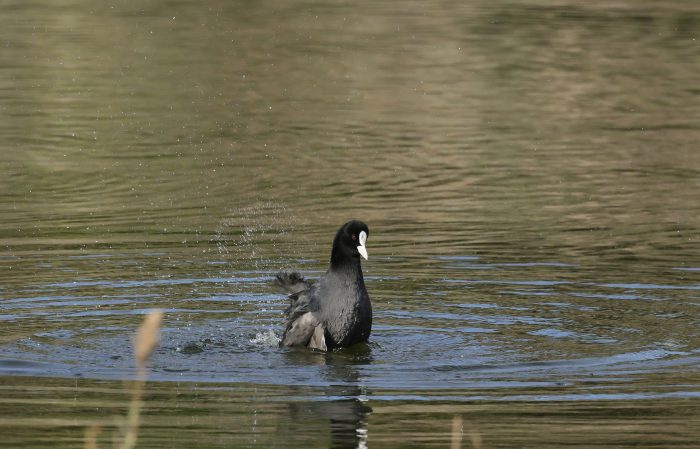
The high water levels have gradually submerged most shorelines reaching the higher parts of the islands. These areas are mostly vegetated and most waterfowl present, including also Common Moorhens and Western Water Rails, predominantly feed here. These vegetated habitats, which also include several Tamarisk trees, also attract several other species to feed. The Tamarisk trees are often used for aerial feeding for birds such as Common Chiffchaffs which were present in good numbers often reaching up to 50. On occasions White Wagtails also feed from perches and in late afternoons a few hundred often congregate in the wetland on their way to their roosting sites. A few Reed Buntings are also observed feeding in the vegetated areas.
An increase in the number of Common Stonechats present throughout the month was noticed, with these birds evidently on migration. Also starting migration were European Robins and Eurasian Blackcaps. A few Song Thrushes frequently visited the reserve, mainly the wooded areas. On the other hand a Grey Wagtail mainly frequented the canal area. Great Cormorants feeding out in the bay often flew over with the highest count being of about 240. Black-headed Gulls also feeding in the bay occasionally flew into the reserve. The first expected Northern House Martins also arrived with 1-2 on a few days.



Works
Besides collecting data from several research programmes, the main habitat management work was the pruning of the Olive trees in the woodland. The selected trees were pruned in a way to improve the tree’s health but also to allow more sunlight to penetrate parts of the woodland. This is part of the woodland management programme carried out in recent years to increase the biodiversity of the area. The long-term benefits are increase in plant diversity and associated wildlife.
Foresta 2000
Sightings
Foresta 2000 kicked off the new year with a lush, green landscape adorned by the first signs of blooming flowers. French Daffodil adds a vibrant touch, brightening the hills with its white accents against yellow Cape Sorel. One can spot the blooming Sulla and the initial stages of Bitter Almond and Strawberry Tree blossoms. Winter rains have replenished the rock pools, attracting wandering snails, such as the Brown Garden Snail.


From left to right: French Daffodil and Strawberry Tree
Avian enthusiasts can delight in the presence of winter visitors — Starlings, White Wagtails, Eurasian Blackcaps and European Robins were present in large numbers. A few pairs of Common Stonechats are present in the reserve. Zitting Cisticolas and Sardinian Warblers add to the lively spectacle with their active flights and melodious songs. For those seeking a glimpse of the Blue Rock-thrush and Black Redstart, the western cliffs overlooking the valley remain the prime observation spot. Occasionally, raptors soar majestically over Foresta, adding a thrilling dimension to the sightings.

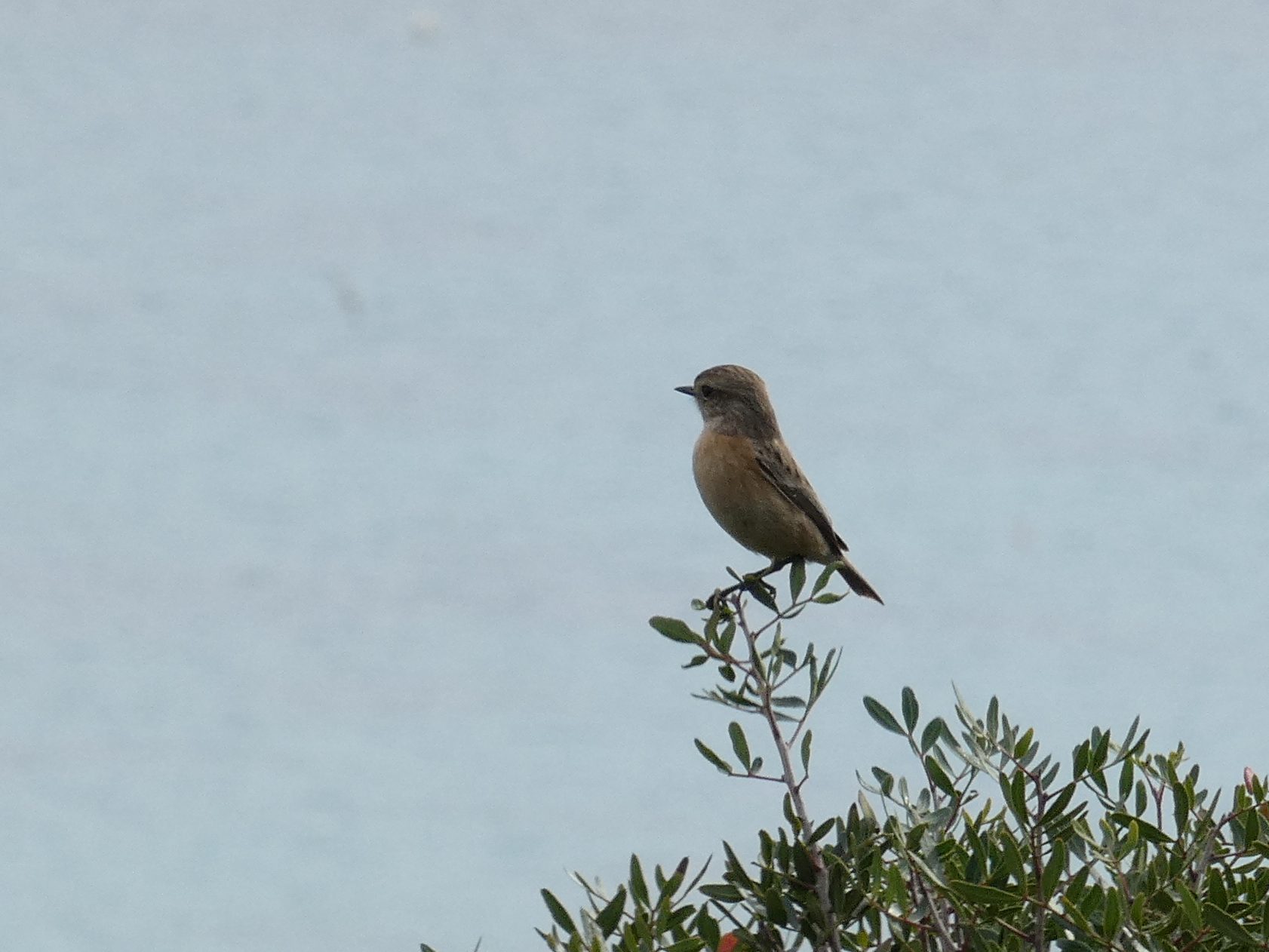

From left to right: Common Starlings, Common Stonechat, Brown Garden Snail
Works
The area underwent weekly cleaning and monitoring. To enhance accessibility, diligent efforts were directed towards pruning fallen trees along the path, ensuring a comfortable and unobstructed journey through the surroundings. The western gate was fixed.

Malta should ensure sustainable use of its groundwater!
Last month the Environment and Resources Authority (ERA) together with the Energy and Water Agency (EWA) presented a draft Green Paper on the Regulation of Groundwater Abstraction in the Maltese Islands. As part of a public consultation on this document, we submitted our recommendations calling for a better integration of environmental considerations into the proposed regulations (our comments can be found here). Unsustainable abstraction of groundwater is a great ecological threat, especially in the Mediterranean, where the weather conditions are getting drier and the precipitation patterns are changing. Malta, in turn, has the second highest Water Exploitation Index in Europe, therefore increasing the sustainability of groundwater abstraction and use, vital for the country’s water security, public health and the environment. We recommended ERA and EWA to explore instruments which would ensure efficient use of groundwater resources, including the promotion of rainwater harnessing and storing, encouraging wider use of the so-called New Water, especially in agriculture, etc. At the same time, given the Maltese reality where groundwater sources are under an immense pressure, stronger incentives and conditions may be considered to avoid water wastage.

Water Exploitation Index graph
Call to protect San Anton Gardens from inappropriate development
In January, we also joined other NGOs in objecting to a proposed development in San Anton Gardens, Attard. The planning application PA 7539/23 is featuring plans to turn the old San Anton conservatory into two “multi-purpose halls” which indicate an eventual commercial use of this structure. Such use is likely to bring additional noise and light pollution to the area, increased traffic and parking problems and will breach the Local Plan on the Protection of Gardens. The area of San Anton Gardens is included into the List of Historical Trees having an Antiquarian Importance as per S.L. 445.02; it is a designated Bird Sanctuary. Furthermore, the area is gaining protection as a Grade 1 Scheduled Monument and is within a UCA. The proposed plans are incompatible with the area’s character, they contradict the local plan policies, and will lead to the change of use of the Green Enclave, jeopardising its natural features. We also called on ERA to take action and protect San Anton Gardens from this unacceptable development.
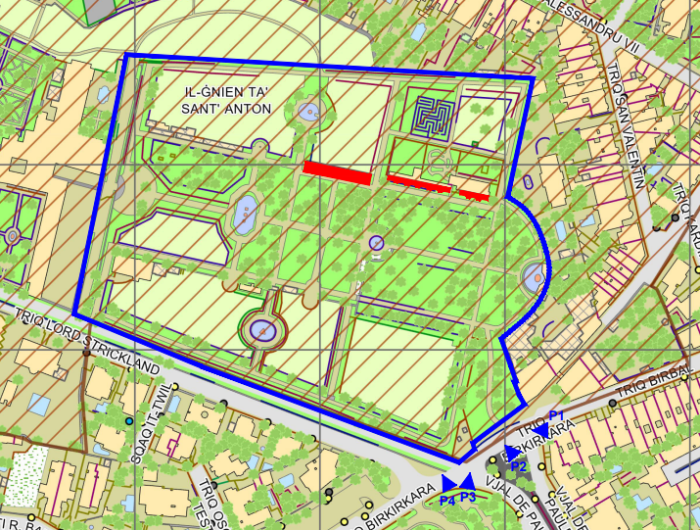

(Left) The site plan. In red are the areas proposed for demolition and construction
(Right) One of the structures which are proposed for demolition

In yellow are the structures to be demolished, in red the ones to be constructed

Alpine Accentor makes rare appearance
At first glance, the Alpine Accentor (Żiemel tal-Alpi in Maltese) might resemble the much commoner Dunnock (Żiemel), yet a closer look will surely reveal a number of differences between these two. At around 17 cm, the Alpine Accentor might not be an easy bird to notice, feeding quietly on the ground, usually in rocky terrain, with its typical low-lying vegetation. It is usually found in mountainous areas at considerable altitude, even beyond 2,000 meters above sea level, yet in winter, some venture to lower areas, occasionally wandering beyond their usual range. Considering the geographical reality of the Maltese Islands, it is no wonder that the presence of an Alpine Accentor in our archipelago – such as this one seen during January – triggers great excitement among the local birding community. Locally, our remote cliffs along the west coast of our islands are usually the best spots to try get a glimpse of this species.


Alpine Accentor
Red-breasted Merganser sighted in Malta
The Red-breasted Merganser (Maltese name: Serra) is a scarce duck that we see in small numbers in winter months. It is mostly seen migrating offshore but in some occasions it is seen resting and feeding in bays and harbours. Pictured here is a young bird, an adult male is more strikingly coloured. They breed on rivers and freshwater lakes in northern countries and then spend the winter at sea. It feeds on fish it catches by diving. Its long, slender beak has small serrations that help it hold on to slippery fish. This has given it its Latin (serrator) and Maltese names (Serra) which both mean ‘saw’. The Red-breasted Merganser is a protected bird in Malta.
Unusual sighting of Marsh-harrier in the midst of winter
The Western Marsh-harrier (Maltese name: Bagħdan Aħmar) is a common spring and autumn migrant seen from March till May and once again from mid-August till November. Up till around 40 years ago Marsh-harriers were commoner in spring but in the past years higher numbers have started to be observed in the autumn months, namely from August till November with numbers peaking in September when it is not uncommon to see over 500 individuals in one day. Occasionally single numbers are also seen in June and December.
This adult female Marsh-harrier was observed flying low over Simar Nature Reserve several times earlier in January in search of prey which mainly consists of aquatic birds and small animals. This is an unusual sighting for this species in the midst of winter; one assumption is that it flew over from nearby Sicily where Marsh-harriers winter in small numbers.
The Marsh-harrier is the largest member of the harrier family. The male’s plumage is distinctively pale grey with dark tips underneath and with a rufous back and body. The female is dark brown with golden patches on the head and shoulders. In Malta the best place to observe these birds of prey in spring are fields harvested with wheat and the airport where they can be seen flying low over the grass in search of prey. In autumn Buskett is the best place, especially in the afternoon where they can be seen soaring and eventually landing in trees or the valley bed to roost.


Western Marsh-harrier
Credits
Words: Polina Venka, Charles Coleiro, David Attard, Nathaniel Attard, Vera Tokmakova, Manuel Mallia.
Photographs: BirdLife Malta, Aron Tanti, Mario V. Gauci, David Attard, Charles Coleiro, Vera Tokmakova, Manuel Mallia, James Aquilina, Murat Gelir, Antoine Monnier, Charles Galea Bonavia, Ian Balzan, Luke Massey, European Environment Agency.
Video: BirdLife Malta.
Editing: Antoine Monnier and Nathaniel Attard.




